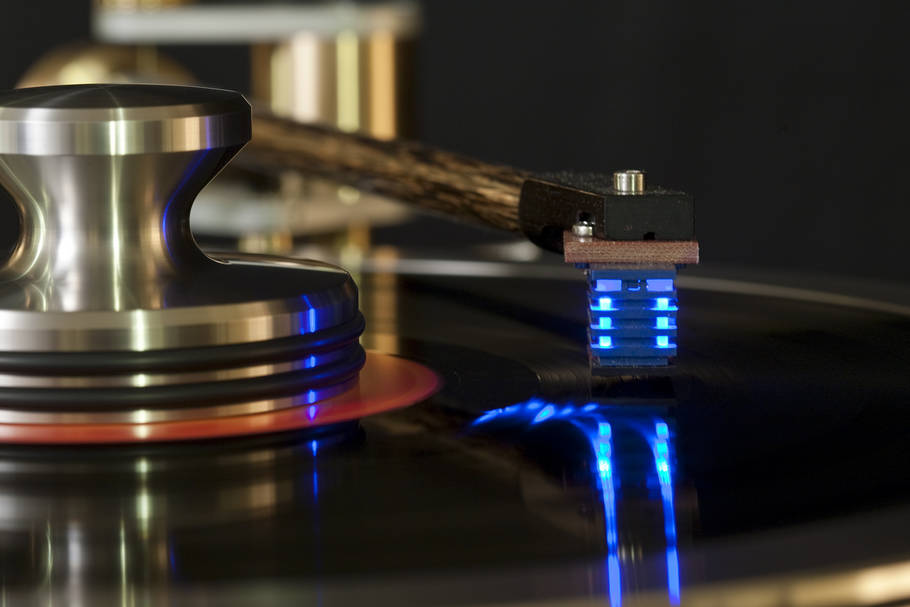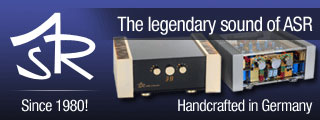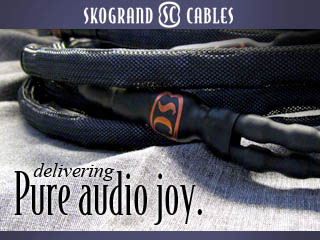
Sound Smith Strain-Guage Cartridge – photograph by Ross Bennett of ~ ImagePro Productions ~ imagepro@earthlink.net
[E]ven if you have heard of a strain-gauge phono cartridge, you probably have never heard one or understood how it works. If you are one of the few who have heard one, it was probably at an audio show in a system you were not familiar with. Still, as rare as they are Soundsmith’s Peter Ledermann is committed to making them available to us. In the midst of repairing vintage equipment, providing the much needed service of retipping and rebuilding phono cartridges, building his extensive lines of wonderful sounding moving-iron cartridges, preamplifiers, amplifiers, and speakers, he also makes a full line of strain-gauge cartridge systems available with a choice of six user-replaceable stylus. Peter says it takes him at least a full day to build just the cartridge itself.
At the 2012 RMAF, Peter Ledermann introduced two new models to compliment the original SG-200 ($6,499): the new SG210 ($7,499), and SG-220. All three models feature MK IV upgrades, the fourth generation of Soundsmith’s strain gauge cartridge systems. As compared to prior iterations, they have improved frequency response characteristics. The top featured model, the $8,600, SG 220 strain-gauge cartridge system in for review includes a dedicated preamplifier for input switching, remote control, fixed and variable outputs. In other words, it’s capable of functioning as a full-fledged preamplifier with one input dedicated to the strain gauge cartridge and one line stage input. It can also be ordered with an adapter to give you four line stage inputs.
Strain-gauge phono cartridges are the stuff of legend. What is the difference between a strain-gauge and a magnetic cartridge? Perhaps the best known strain gauge is the Win Strain-Gauge cartridge. Sao Win has made them off and on for decades. Panasonic also made some years ago, and some are still in service today. Jeff Rowland was so taken with the Panasonic that he made a power device for it. Personally, I’ve never heard either a Win or Panasonic strain-gauge cartridge, though my audio bud Steve says he used to own a Win Labs and loved it. The only ones I have heard are the ones from Soundsmith and up to now, only at shows with equipment I was not familiar with, but the sound intrigued me enough for me to go after Peter to let me review one. He promised me one after the 2012 RMAF, but then the super storm hurricane Sandy came and Peter’s place was hit very hard; however, by late December he had one ready for listening to and reviewing.
To the best of my understanding a strain-gauge cartridge, unlike traditional moving magnet or moving coil cartridges, does not produce voltage or current. In contrast, it responds to mechanical movement or displacement of the grooves by changing resistance. Thus, it requires the use of a separate, dedicated electronic device to generate a direct current in which changes in resistance can then be converted into an analog signal. (Because of the resistance produced by the cartridge, it must be used with a special preamp that in essence, provides a power supply. Whereas typical cartridges respond to velocity, the strain gauge responds to displacement. As such, the strain gauge does not require an RIAA correction. Most importantly, the strain gauge must be used with the Soundsmith preamp; it cannot be mixed and matched with other preamps. -Exec Ed.)
In theory, there are several advantages over traditional cartridges. First, it should provide a relatively flat frequency response over a range that exceeds the audible range. Second, the SG cartridge is a medium-low compliance cartridge that has a much lower effective moving mass than most moving coil cartridges; this should result in a lower level of stored energy reflecting back down the cantilever and stylus to cause distortion or mis-tracking. Third, it is said to be the most phase coherent cartridge system made.
With a strain gauge cartridge the cantilever puts pressure on two sensitive silicon crystals that change resistance as the cantilever moves, in response to the stylus following the grooves of the LP. Unlike other cartridge designs, the cantilever does not have to drive coils or magnets. I’m not by any stretch of the imagination an expert on phono cartridge design, so if you want to understand more of the technical side go to www.sound-smith.com.
Review System
I used the Soundsmith SGG-220 in my reference system. I removed my Miyabi Standard cartridge ($3,500), my Auditorium 23 Homage T1 SUT ($5,000), a meter of High Fidelity Cables CT1E ($2,800), and disconnected my beloved Shindo Giscours ($28,000). In the place of all this equipment, the cost of which is $39,300, I mounted the Soundsmith strain-gauge phono cartridge with the SG-220 as my preamp($8,600). I used my AMG V12 turntable and its 12-inch tonearm, placed on the HRS M3X-1921-AMG isolation platform made for the V12. The power amp for the review was my Wavac EC 300B, and the speakers were my Teresonic Ingenium XR Silvers. All interconnects and speaker cables were Rick Schultz’s High Fidelity Cables. Power condition was from HB Cable Design PowerStar Horizon and Audience AU24 power cables. I also listened to the Soundsmith cartridge through the SG-220’s fixed outputs into the Shindo Giscours’ line stage.
Setup
Everything I had read and things Peter said about the SG-220 made me think setting up this cartridge would be a bear. Nothing could be further from the truth. I want to compliment Peter for one of the best owners’ manuals and setup instruction I have seen in audio. I would like to encourage anyone purchasing this cartridge to read it thoroughly before setting up the cartridge. I found mounting it in my AMG V12 tonearm a snap, and its rectangular shape made getting the geometry right straightforward. I followed the method outlined in the instruction manual for setting the azimuth. This involves the use of flashlight and your eyes. I double checked it with a Fozgometer and a test record, but it was right on just using the flashlight as Peter instructs.
One word of warning though, the stylus in this cartridge sits much farther back in the cartridge than most. Thus it is easy to get the geometry a little off if you aren’t careful about where you place the stylus versus where it usually is. The first time I set it up I caught myself doing this, and even after break-in, it sounded a little lean; when I went back and checked everything, I discovered I had not gotten the stylus itself right on the spot on the protractor. When I did, the sound snapped into place and the slightly lean sound went away.
Tracking force is checked before Peter ships it out, and he writes the recommended tracking force on the box. Mine had 2.4 grams on the box and I tried it a little bit up and down, and I need to say that small differences in VTF made significant differences in my system. I settled on about 2.415g.
This leaves VTA to set, and that is a very simple and easy thing to do with the AMG V12 tonearm. I don’t buy into setting VTA with a microscope; I trust my ears. By the way I have discovered that this is the biggest mistake most audiophiles make, not trusting their own ears. Again, like VTF the small changes in VTA made significant difference in my system. Since VTF also effects VTA, I tried to get the VTA so that I could keep the VTF as close to 2.4g as possible and get the best sound. In my system it sounded best with it back down just a hair, and I mean a hair. If the VTA is too high or the VTF too low, the cartridge sounded a little thin and didn’t quite pop like it did when I got them right.
In the end, the cartridge did take more time to set up than most. There is this special balancing act between VTA and VTF and of course every time you change the VTA you have to get the protractor out and reset things. I ended up getting the best sound using the late Allen Wright’s protractor which you can still print out from VSEI’s web site. The way I finally got it tuned in was using a LP I was very familiar with — Carol King’s Tapestry, a LP I have listened to since my college days. To get the protractor setting perfect I had to increase the VTF to 2.48, so I lowered the VTA and then tried to get the VTF back to 2.4. I settled on this VTA and a VTF of 2.415. Of course, lowering the arm meant I had to redo the geometry.
This may sound like a lot of work, but it wasn’t very hard with my arm, and it was worth it. Without this fine tuning the cartridge can sound thin on some LPs, but after getting this all set up the cartridge is not thin at all, but has beautiful harmonics and deep layering. This is why I don’t think you can set up a cartridge with a microscope. You need something to get you to a starting point like a level or with the AMG tonearm’s built-in level, but after that you have to listen. It’s worth the effort, I promise.
One last thing, it seems to me that a preamp never sounds its best for the first two or three minutes it is played. Maybe I should just leave it on all the time but I just got used to this.
- (Page 1 of 4)
- Next page →




I’ve been fortunate enough to have owned a Strain Gauge cartridge for nearly 2 years now. Whilst your review may appear as an uncritical gushingly positive review, it is in concordance with my own experience. All I would add to your review is to emphasise how well the SG presents musical timbre, it isn’t just drums that sound like real drums, all instruments are presented with a natural life-like timbre.
The other interesting observations with this cartridge are:
That some LPs that sounded terrible with my previous cartridge (ZYX Airy 3) now sound great, but also vice versa.
Part of what is different is the incredibly low noise floor, I never realised how noisy MC cartridges were until I didn’t have one.
Mono albums sound great with this cartridge, nobody else had mentioned this before – I thought that it was just me!
It was interesting that you mentioned the Decca London, I had an original Garrott Brothers modified Decca and this has been the cartridge that I’ve enjoyed the most until I bought the Strain Gauge.
Thanks Prof for reading the review and it’s great to hear that you have had the cartridge for two years and still loving it. To me that says it all. It’s not uncommon for people to love a new purchase and with time to feel it wasn’t as good as they thought.
Thank you so much for your comments and I agree with your comments about the timbre of instruments. Now that I’m just listening to music and not reviewing it I am enjoying it even more.
Dear Mr. Roberts,
I completely agree with you about the Strain Gauge principle. Almost fifty years ago, as a student, I got the opportunity to help to build the Euphonics Miniconic System. The Design was straightforward. We had two problems; first because of the construction, one of the two channels needed an
inverter-stage (At that time we had only some Ge-transistors and no differential-amplifiers!). The second problem was the choice of the best
material for the suspension.
Fortunately, at NASA in Houston, they stock an enormous choice of different rubbers. We decide to use a natural butyl-rubber… They were endless discussions about the influence of the rubber in the resulting aesthetic of the sound!
Now, I am still using the Euphonics, together with the SG RAM preamp that Peter Ledermann designed for the Matsushita SG at RAM Audio. About wearing? From my own experience, no problem after 45 years of use. I had some trouble at the beginning, not because of the SG, they were already very reliable (NASA used them to test the deformations on the Polaris-rockets) but the contacting between the small epoxy SG-holder and the outside world was very poor. On my system, I took out the contacts, just soldering four tiny wires direct on the epoxy.
About my sound experience; I had plenty of carts (MM-Shure, MC-Dynavector, etc) I still prefer the sound of the SG. It gives me fantastic dry bass and crystal clear high frequencies. I connect Mr. Ledermann’s RAM preamp direct to the power amplifier. Especially if you use Direct Disc Records (Sheffield Labs, Three Blind Mice) you get a near reality sound experience!
Now, as a retired engineer, I hope that I will raise enough money to afford the SG-220.
I hope I was not disturbing you too much with my stories. Thank you very much for your engagement for the survival (or revival) of the
SG-principle. A system responding to the displacement (amplitude) will be, for me, always better than one using the derivative of the signal (velocity)!
I send you my best regards
Dr. Yves Lehareinger
P.S. Almost 50 years ago, I got the same feeling as you, discovering Peter Walker’s wonderful ELS 57!
Many years ago I, for a short while owned a Win SG. As I have heard here, I’m recalling a not so subtle difference in the reality presented with the strain guage. It’s startling.
On the opening of one of my favorite albums, Better Days by Paul Butterfield, there is a short dialogue. “OK Nick” I believe one of the band members says. My dog Lea jumped up, although she had heard the album many times. Closest to reality of any medium of reproduction I’ve ever heard. One day sir, one day I’ll have one.
Peter’s miraculous Strain Gauge has been my reference cartridge since 2011 and is used each week by to dub vinyl sources for my web show “The Vinyl Experience.” I concur with all of the observations of this comprehensive review. It sounds neither analog or digital, but rather like a unique window into original sources. I too have wrangled the joys and sorrows of the quirky London Decca line of cartridges and find the SG to absolutely be a ‘Decca that actually tracks,’ a unicorn in the Hi Fi woods if there ever was one. Most significantly, our glowing little blue creature is it’s own animal, and a brilliant reflection of it’s creator and his own clear values. The cautionary words about geometry and set-up are well advised–I’ve lived with mine for nearly a college-career of years and I’m still tweaking. This is a cartridge that rewards a well-balanced system of components that get out of the way, and that includes simplifying all aspects of set-up. If your tonearm eschews goofy little things like height or azimuth adjustment or wiggle room in those headshell slots, you’re sunk. A Soundsmith Strain Gauge demands it, and delivers rewards in proportion to the effort expended. It’s a tweaker’s cartridge, and proudly so. The great thing about vinyl: if you just want to “never mind the bollocks’ and simply play records, you can spend hundreds-not thousands-and get bang for buck with wonderful new things like (for instance) Rega’s P1. But if tweaking is the whole idea, and peeling the layers of the audio onion your great pleasure, every penny spent on the SG will come back to you in glorious dollops of obsession.